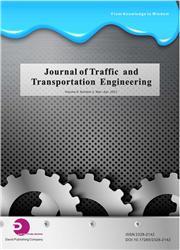Mining Urban Congestion Evolution Characteristics Based on Taxi GPS Trajectories
引用次数: 1
Abstract
The taxi GPS trajectories involve sufficient temporal and spatial characteristics and make it easy for us to obtain potential knowledge for understanding human mobility pattern and urban traffic network dynamics. Sensing urban traffic conditions not only enables traffic management authority to improve urban traffic management. It can also provide decision-making for residents and taxi drivers. A spectral clustering method is proposed for sensing traffic congestion using taxi GPS trajectories. First, taxi GPS trajectories are pre-processed and matched with the urban road network established based on the primal graph representation. Second, the average speed of the road segments is obtained according to the taxi GPS trajectories and a dynamic weighted graph of urban road network is constructed to capture complicated urban traffic network. Then, a spectral clustering method is developed to detect the urban traffic congestion. Finally, the congestion evolution characteristics in Lanzhou, China are visualized and analyzed during different periods in the weekdays and weekends. Experimental results show that the proposed method can effectively detect traffic congestion, and the results are consistent with the usual actual experience. Compared with other traffic congestion methods, the proposed method can detect urban traffic congestion with wider coverage and lower cost. Therefore, the proposed method can be integrated into the classic intelligent traffic system, assisting urban traffic prediction, personal travel route plan, route planning and navigation application.基于出租车GPS轨迹的城市拥堵演化特征挖掘
出租车GPS轨迹包含了充分的时空特征,为我们理解人类出行模式和城市交通网络动态提供了潜在的知识。感知城市交通状况不仅可以使交通管理部门改善城市交通管理。它还可以为居民和出租车司机提供决策。提出了一种利用出租车GPS轨迹感知交通拥堵的频谱聚类方法。首先,对出租车GPS轨迹进行预处理,并与基于原始图表示建立的城市路网进行匹配。其次,根据出租车GPS轨迹获取路段平均速度,构建城市路网动态加权图,捕捉复杂的城市交通网络;在此基础上,提出了一种用于城市交通拥堵检测的光谱聚类方法。最后,对兰州市工作日和周末不同时段的拥堵演变特征进行了可视化分析。实验结果表明,该方法可以有效地检测交通拥堵,结果与通常的实际经验一致。与其他交通拥堵检测方法相比,该方法检测城市交通拥堵的覆盖范围更广,成本更低。因此,所提出的方法可以集成到经典的智能交通系统中,辅助城市交通预测、个人出行路线规划、路线规划和导航应用。
本文章由计算机程序翻译,如有差异,请以英文原文为准。
求助全文
约1分钟内获得全文
求助全文

 求助内容:
求助内容: 应助结果提醒方式:
应助结果提醒方式:


